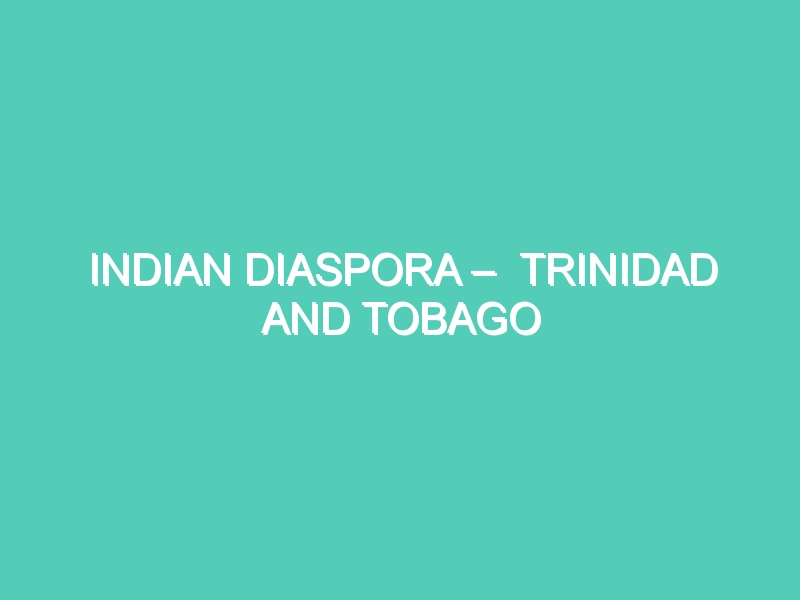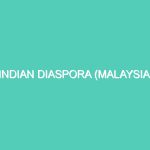India and the Republic of Trinidad and Tobago have enjoyed dynamic bilateral relations for more than a long time of 70 years since the foundation of the Indian Mission in Trinidad and Tobago’s capital city in Port of Spain in July 1948. It was one of India’s first discretionary relations built up in the Caribbean locale adhering to its Independence from British principle. Be that as it may, as per the Special Report on India and Trinidad and Tobago (2014:8), the connection among India and Trinidad and Tobago began on 30 May 1845, when the main ship ‘Fatel Razack’ conveying 225 obligated labourers from India arrived at the shores of Trinidad, at that point a British settlement. Their numbers expanded with the ensuing appearance of more ships from India. The relatives of those labourers, presently in their fifth era are a vital part of the financial, political and social texture of the nation.
On August 6, 1962, soon after TRINIDAD & TOBAGO’s Independence, India’s first High Commissioner was appointed and in the same year, TRINIDAD & TOBAGO opened their High Commission in New Delhi.[1]
My article discusses the state-Diaspora relations between Trinidad and Tobago with India along the two time periods i.e. during indentureship and post indentureship.
The sub-landmass of India contributed around 143,000 contracted labourers to Trinidad somewhere around the time from 1845 and 1917. A dominant part of these Indian emigrated people originated from Northern India, primarily from the areas of United Provinces and Bihar. A greater part of Indian workers settled in Trinidad and even now notice with satisfaction the area, district (Zila), monetary unit (Pargana) and town from where their ancestors came. From 1845 onwards, Indian migrants gushed into the settlement on shiploads bound to legally binding work enduring three to five years with a choice to return back after the time of indentureship. However some of them returned. Around 134,183 Indians settled in Trinidad during the period 1845 – 1917 (obligated work displacement to the Caribbean finished in 1917 with entry of empowering British enactment) and their quality had a genuine effect to the physical and social scene of this country.[2]
The relations among India and Trinidad and Tobago has moved from a negligible indication of social, strict and chronicled ties which structure some portion of the Indian legacy comprising of roughly 42 percent of a populace of 1.3 million individuals, to genuine business and monetary connections prefaced on understandings and joint venture partnerships, interests in money related administrations, pharmaceuticals, the travel industry, medication, and perceivability in gatherings, exchange fairs and shows. The Indian Diaspora in Trinidad and Tobago has hence moved on from indentureship to business enterprise. They comprise business magnates, business visionaries, producers; experts spoke to in legislative issues, law, medication, the scholarly world and such. Maybe no field of social, social, monetary and political action is left uninfluenced by individuals of Indian plummet. India and Trinidad & Tobago: Diaspora Building and Diaspora Integration – Implications for Emigration States
The other part of the community, NRIs, comprises around 500 families, generally occupied with business, teachers and callings. Two Indian PSUs, Bank of Baroda (with 3 branches) and New India Assurance are in activity while Arcelor Mittal, the biggest steel plant in the Caribbean, contributes the most elevated GDP outside of the vitality business, and has a larger part share in the Inter-Commercial Bank. Indian organizations like Berger Paints and Ranbaxy are also present. Other than this Indian dealers do visit every once in a while to compose exchange fairs which have made Indian articles of clothing, adornments, furniture and handicrafts work well known in the nation.
The Diaspora is an imposing power in Trinidad, the biggest numerical portrayal in the whole Caribbean; the wealthiest and socially solid and dynamic ethnic gathering in the particularly plural society of T&T. They need consolation and their desires from India as far as social and passionate commitment and food should be met to strengthen the chronicled joins between our two nations.
In the absence of any diplomatic post during the time of the indentureship, it Indian migrants who moved there at an early time created their mechanisms to survive in that alien land. With them they brought their rich cultural heritage in both tangible and intangible forms, wrapped up in a jahaji bundle. The two major forms of spiritual sustenance brought by them were The Holy Quran and the Tulsidas Ramayan.
People who arrived at Trinidad and Tobago were from different religions, cultures, castes, economic class and geographical regions in India and about 85% of them were Hindus, 15% Muslims and 0.1% were Christians.
The earliest holding among the Indian workers occurred on the board of the first ship, Fatel Rozack to the shores of Trinidad. To endure the tricky excursion over the oceans [referred to as kala pani or dull waters], to the obscure remote land, workers from all layers [caste, religion, class and ethnicity] found comfort in one another’s organization and built up selfless bonds that became known as Jahaji bhai [Ship brotherhood].[3]
The obligation of fraternity expanded further as the workers, the two people worked together in sugar estates under the British colonizers. Obligated workers started to structure new connection arranges even before they showed up in Trinidad. Close connections framed on shipboards were kept up for quite a long time, even ages, to the degree that practically speaking the obligated workers would not permit their kids to wed one another. They helped each other to discover life partners for their youngsters in discrete towns as their family members did in India.[4]
The initial two decades of bringing Indian people to Trinidad were profoundly an experiment in nature, ailing in settled guidelines and conditions. However, there were two focal and consistent highlights of the framework: outsiders were contracted for significant stretches with a solitary business, and, there were penal sanctions for breaches of the agreement. From the Immigration Ordinance of 1854 until 1917, the framework remained generally steady with a couple of striking changes, a generally critical of which, for Trinidad, was the allowing of Crown land in lieu of the free return entry somewhere in the range of 1869 and 1880. On appearance in Trinidad the obligated migrants were isolated on Nelson Island and afterward doled out to the different homes for the contracted multi year time frame; this was trailed by a two year duration which finished the “industrial habitation” of five years. Toward the finish of this two year time frame, the Indian migrant would be conceded his Certificate of Industrial Residence, such an “opportunity paper” ensuring that the individual was not, at this point under agreement. In any case, so as to fit the bill for the free return section back to India, the Indian needed to re-arrangement himself for a further five years, however was allowed to pick both manager and occupation. The main option for coming back to India without finishing the full ten years of work in the state was at one’s own cost.[5]
The arrival of the Indian obligated workers into Trinidad appeared to give the solution for the existent monetary and work related emergency of the time. It additionally observed the acquaintance of another measurement with the social and social texture of Trinidad society. The dynamism of the experience of Indian agreement is obvious in the diverse discussions that it has brought forth; discusses that persistently reaffirm the worldwide nearness and commitment of the Indian arrangement Diaspora.[6]
Article Written By- Manisha
Law Student–Dr. B.R. Ambedkar National law university, Sonepat
(HRDI Work From Home Internship)
[1] India and Trinidad & Tobago: Diaspora Building and Diaspora Integration – Implications For Emigration States, available at – https://pdfs.semanticscholar.org/03e6/51d80e3d7f23b034a3fa3ea7867d28888dcf.pdf (last visited – 10 July, 2020)
[2] Diaspora in Trinidad and Tobago, available at – https://www.hcipos.gov.in/page/diaspora-in-trinidad-and-tobago/ (last visited – 10 July 2020)
[3] India and Trinidad & Tobago: Diaspora Building and Diaspora Integration – Implications For Emigration States, available at – https://pdfs.semanticscholar.org/03e6/51d80e3d7f23b034a3fa3ea7867d28888dcf.pdf (last visited – 10 July, 2020)
[4] India and Trinidad & Tobago: Diaspora Building and Diaspora Integration – Implications For Emigration States, available at – https://pdfs.semanticscholar.org/03e6/51d80e3d7f23b034a3fa3ea7867d28888dcf.pdf (last visited – 10 July, 2020)
[5] The experience of Indian Indenture in Trinidad arrival and settlement, available at – https://www.caribbean-atlas.com/en/themes/waves-of-colonization-and-control-in-the-caribbean/waves-of-colonization/the-experience-of-indian-indenture-in-trinidad-arrival-and-settlement.html (last visited – 10 July 2020)
[6] The experience of Indian Indenture in Trinidad arrival and settlement, available at – https://www.caribbean-atlas.com/en/themes/waves-of-colonization-and-control-in-the-caribbean/waves-of-colonization/the-experience-of-indian-indenture-in-trinidad-arrival-and-settlement.html (last visited – 10 July 2020)



